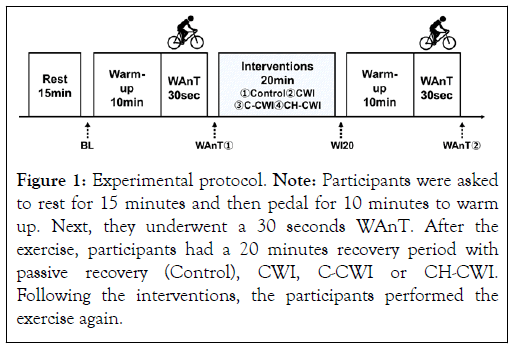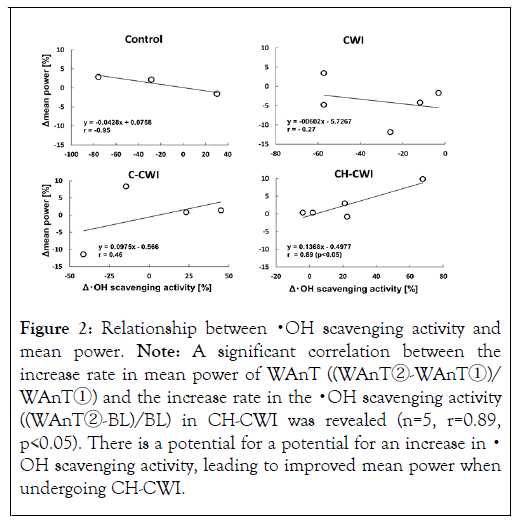International Journal of Physical Medicine & Rehabilitation
Open Access
ISSN: 2329-9096
+44 1300 500008
ISSN: 2329-9096
+44 1300 500008
Mini Review - (2023)Volume 11, Issue 11
A Cold therapy is widely recognized as a prescription for acute-phase recovery in athletes. However, it has been suggested that vasoconstriction caused by cooling may, in fact, delay the recovery process after exercise. Therefore, we are researching a new cooling method that involves supplementing ice baths with carbon dioxide gas, which has vasodilatory effects, and hydrogen gas, which has anti-inflammatory properties. This new approach aims to improve muscle blood flow and performance while maintaining the benefits of cooling, such as pain alleviation. This mini review provides an overview of the acute recovery effects of this innovative method and its potential applications.
Cold-water immersion; Carbon dioxide; Hydrogen; Muscle damage; Recovery; Athlete
Cold-water immersion after exercise has become a common practice on the competitive sports scene. Athletes engage in daily training to enhance their performance and may participate in multiple competitions a day, sometimes consecutively. Therefore, discovering a body conditioning strategy for the period of a match (e.g. in sports) and the most effective recovery regimen is crucial for improving performance and preventing fatigue-related injury. Cooling is one of the most widely utilized acute-phase treatments [1-3]. In particular, Cold-Water Immersion (CWI) after exercise has been reported to decrease muscle damage markers such as creatine kinase and to reduce muscle fatigue and muscle soreness [4-6]. However, recent studies have indicated that the cooling stimulus induces vasoconstriction, thereby decreasing blood flow and delaying the recovery of injured tissues [7]. Given this paradox, we have pursued innovative recovery methods that facilitate patent blood flow while taking advantage of the anti-inflammatory and analgesic effects of cooling. The purpose of the present work is to review the physiological effects of external exposure to dissolved carbon dioxide (CO2) gas and the combination of dissolved CO2 and hydrogen (H2) gas on exercise performance in healthy subjects. This mini-review is based on our previous literature to identify potential athletic performance recovery and the possibility of future research.
Cold-Water Immersion (CWI)
Clinicians CWI is a kind of cryotherapy in which the whole body is immersed in cold water, and it has become widely popular. However, when it comes to the effects of CWI on performance recovery, both positive and negative observations have been reported, and no consensus has been reached [8-10]. In a 2020 meta-analysis of male athletes, CWI following resistance exercise sessions attenuated improvements in muscular strength [11]. Another study suggested that the cooling stimulus provided by CWI may induce vasoconstriction, thus reducing blood flow [7]. Previous studies focused on the kinetics of lactate clearance from the bloodstream have highlighted a notable relationship between blood flow and lactate removal [12,13]. The cooling stimulus from CWI leads to vasoconstriction, which may potentially delay the arrival of recovery mediators and inhibit the removal of lactate and other inflammatory substances by reducing blood flow. Although there is no consensus on the short-and long-term effects of CWI, it is apparent that effective CWI treatment for injured muscles must address the issue of reduced blood flow.
Carbon dioxide vasodilation
External exposure to dissolved CO2 into water is used as a type of thermotherapy, with reported effects such as peripheral vasodilatation, increased blood flow, and heat retention [14,15]. Hartmann reported that approximately 3% of CO2 is physiologically released through the skin. However, when the CO2 concentration saturates the environment around the body, CO2 absorption also takes place through the skin, both in its gaseous form and via water containing carbonic acid [16]. Upon skin absorption or permeation, CO2 gas generates hydrogen ions through buffering. These ions act upon the smooth muscles of cutaneous blood vessels, particularly the small arteries of the anterior capillaries, inducing relaxation of the vascular smooth muscles. This relaxation causes dilation of the vessels and consequent elevation in cutaneous blood flow [17,18]. Furthermore, there is an indication that the blood flowenhancing effect of carbonated spring water not only impacts surface tissues but also extends to muscles [19].
Vasodilation during cooling
There have been few prior studies concerning recovery involving the combination of cold water and CO2 gas. To confirm whether the vasodilatory effects of CO2 gas could be activated in the context of cold-water immersion, we conducted a foundational study. We prepared both CWI and CWI with CO2 concentrations above 1000 ppm (C-CWI) at 20°C and assessed the changes in physiological parameters and tissue oxygenation dynamics when one leg was immersed up to the knee [20]. Our investigation demonstrated that in C-CWI, there was a greater increase in arterial blood flow compared to CWI. In addition, during the 18-minute recovery period after immersion, we observed that heat dissipation was significantly accelerated [20]. Subsequent research involving post-bicycle exercise performance measurements confirmed that C-CWI significantly reduced deep body temperature and accelerated lactate clearance [21]. When evaluated from the perspective of athletic performance recovery, we observed a strong correlation between acceleration of lactate clearance after water immersion and cycling efficiency or the decrease in peak pedal repetitions of cycling [20,21]. These observations in our previous studies underlined the effectiveness of recovery by immersion in cold carbonated water [21,22].
Antioxidant action of hydrogen
Exposure to dissolved Hydrogen molecular (H2) gas immediately after high-intensity exercise has also been tried as a strategy for decreasing inflammation and muscle injury [23]. H2 can be absorbed by the body through a variety of routes, including drinking and soaking. H2 is thought to selectively neutralize hydroxyl radicals and peroxynitrite in cells and exhibit cytoprotective effects against oxidative stress [24]. For instance, Kawamura evaluated the pain associated with Delayed Onset Muscle Soreness (DOMS) using a visual analog scale [25]. They noted that even though H2 soaking does not affect theinflammatory response, pain levels in DOMS may be alleviated by H2 soaking.
Our recent research suggests the potential for alleviating several symptoms of DOMS, which typically occur 48-72 hours after eccentric exercise, by implementing a combination of dissolved CO2 and H2 gas in Cold Water Immersion (CH-CWI) [26]. Specifically, within the CH-CWI group, there were no significant decreases in measures such as maximal voluntary isometric contraction torque, countermovement jump height, and knee flexion range of motion while the other groups (Control, CWI, and C-CWI) showed significant decreases in these variables. Additionally, echo intensity and tissue hardness showed no significant increases in the CH-CWI group [26]. However, it is not clear how H2 gas in CH-CWI promotes scavenging of Reactive Oxygen Species (ROS) and suppresses inflammation and muscle damage.
Here, we present reference data for the outcomes of the CWI with CO2 gas and H2 gas. Twenty trained male athletes (age 20.6 ± 1.2 years, height 173.1 ± 5.1 cm, weight 69.9 ± 7.0 kg; means ± Standard Deviations (SDs)) were randomized into four groups (① Control, ② CWI, ③ C-CWI, and ④ CH-CWI). In the three CWI groups, all participants were immersed in one of the three baths at 20ºC for 20 min immediately after the first highintensity Wingate Anaerobic Test (WAnT). After the recovery intervention, the participants performed the second WAnT (Figure 1). Their heart rate, core body temperature, blood lactate, and ROS including Hydroxyl radicals (・OH) were measured four times at Basal Rest (BL), the end of First WAnT (WAnT①), recovery Intervention (WI20) and the end of Second WAnT (WAnT②). The mean power output of WAnT was also measured at the first bout and the second bout following each recovery intervention. The Electron Spin Resonance (ESR) spin-trapping method is able to detect ROS and evaluate ・OH elimination activities using the Multiple Free-Radical Scavenging (MULTIS) method. As a result, a significant correlation between the rate of increase in mean power of WAnT from the 1st bout to the 2nd bout and the rate of increase in the ・OH scavenging activity was observed only in the CH-CWI group (n=5, r=0.89, p<0.05) (Figure 2).

Figure 1: Experimental protocol. Note: Participants were asked to rest for 15 minutes and then pedal for 10 minutes to warm up. Next, they underwent a 30 seconds WAnT. After the exercise, participants had a 20 minutes recovery period with passive recovery (Control), CWI, C-CWI or CH-CWI. Following the interventions, the participants performed the exercise again.

Figure 2: Relationship between ・OH scavenging activity and mean power. Note: A significant correlation between the increase rate in mean power of WAnT ((WAnT②-WAnT①)/ WAnT①) and the increase rate in the ・OH scavenging activity ((WAnT②-BL)/BL) in CH-CWI was revealed (n=5, r=0.89, p<0.05). There is a potential for a potential for an increase in ・ OH scavenging activity, leading to improved mean power when undergoing CH-CWI.
We investigated whether the new CWI method, which involves external exposure to dissolved CO2 gas and H2 gas, has an effective impact on fatigue, increased body temperature and energy efficiency for athletes. It was confirmed that arterial blood flow significantly increases and heat dissipation is promoted by CO2-rich CWI. Furthermore, this enhanced blood flow is suggested to contribute to the rapid removal of lactate. Based on these findings, it is reasonable to conclude that there are clear benefits to incorporating CO2 gas into CWI. This treatment effectively addresses the issue of decreased blood flow associated with cooling.
Moreover, by adding H2 gas to the C-CWI, there was an indication of the potential to alleviate some symptoms of DOMS induced by eccentric exercise. This suggests a possible reduction in muscle inflammation due to CH-CWI, indicating the positive anti-inflammatory effects of hydrogen gas. It has been established that hydrogen gas enhances ・OH scavenging activity, and our reference data revealed a correlation between ・OH scavenging activity and an increase in the mean power of the Wingate test. Further analysis is required to understand the mechanism of interaction between CO2 gas and H2 gas.
This study was approved by the Ethics Committee of the Institutional Review Board of the Doshisha University, Kyoto, Japan (no.19023), and complied with the requirements of the Declaration of Helsinki.
The authors have no conflicts of interest relevant to this article.
This study was supported by an Osaka City Innovation Creation Support Grant (2019).
[Crossref] [Google Scholar] [PubMed]
[Crossref] [Google Scholar] [PubMed]
[Crossref] [Google Scholar] [PubMed]
[Crossref] [Google Scholar] [PubMed]
[Crossref] [Google Scholar] [PubMed]
[Crossref] [Google Scholar] [PubMed]
[Crossref] [Google Scholar] [PubMed]
[Crossref] [Google Scholar] [PubMed]
[Crossref] [Google Scholar] [PubMed]
[Crossref] [Google Scholar] [PubMed]
[Crossref] [Google Scholar] [PubMed]
[Crossref] [Google Scholar] [PubMed]
[Crossref] [Google Scholar] [PubMed]
[Crossref] [Google Scholar] [PubMed]
[Crossref] [Google Scholar] [PubMed]
[Crossref] [Google Scholar] [PubMed]
[Crossref] [Google Scholar] [PubMed]
[Crossref] [Google Scholar] [PubMed]
[Crossref] [Google Scholar] [PubMed]
[Crossref] [Google Scholar] [PubMed]
Citation: Yoshimura M, Fukuoka Y, Sawada Y, Ichikawa H, Nakamura M (2023) Enhanced Athletic Recovery Using Cold-Water Immersion with Dissolved CO2 and H2. Int J Phys Med Rehabil. 11:704.
Received: 08-Nov-2023, Manuscript No. JPMR-23-27952; Editor assigned: 10-Nov-2023, Pre QC No. JPMR-23-27952 (PQ); Reviewed: 28-Nov-2023, QC No. JPMR-23-27952; Revised: 06-Dec-2023, Manuscript No. JPMR-23-27952 (R); Published: 14-Dec-2023 , DOI: 10.35248/2329-9096.23.11.704
Copyright: © 2023 Yoshimura M, et al. This is an open-access article distributed under the terms of the Creative Commons Attribution License, which permits unrestricted use, distribution, and reproduction in any medium, provided the original author and source are credited.